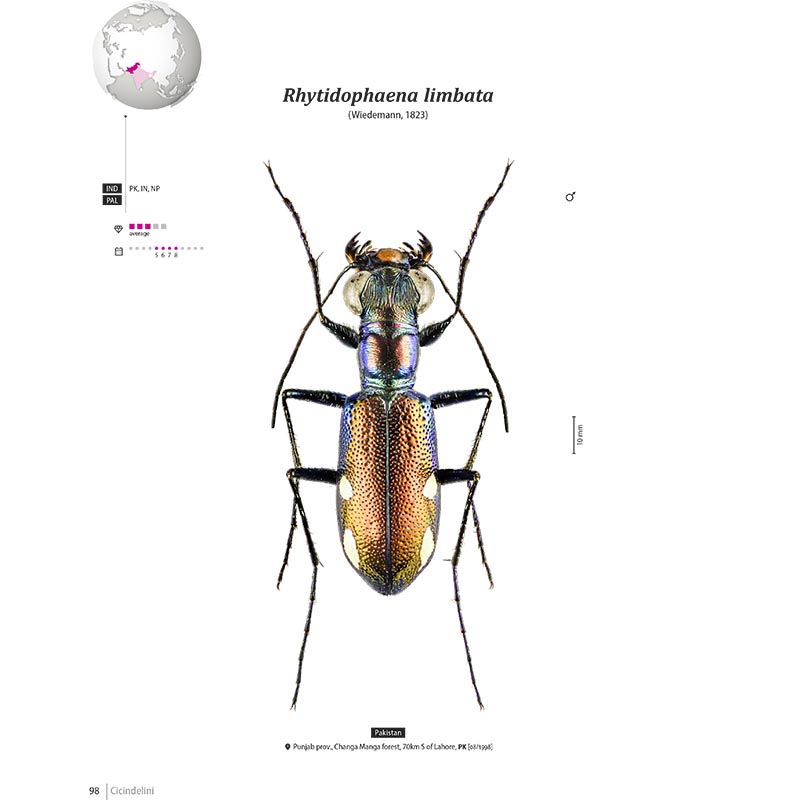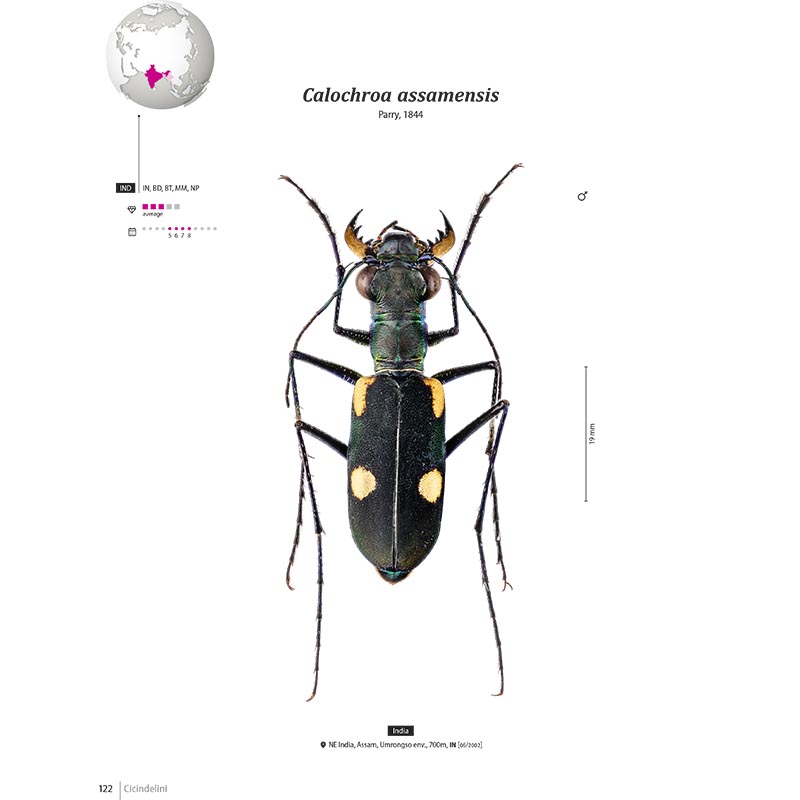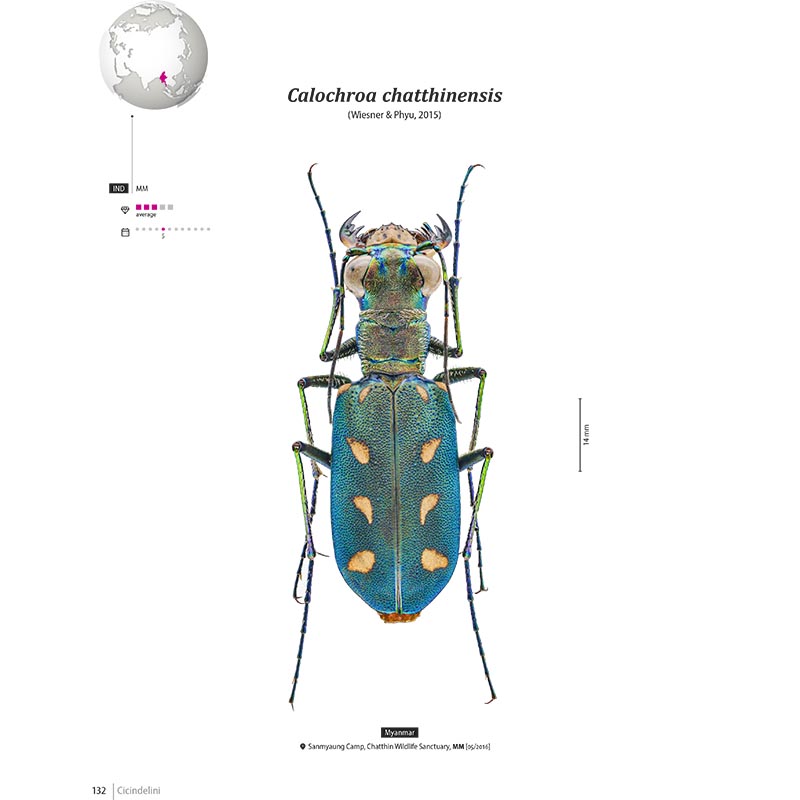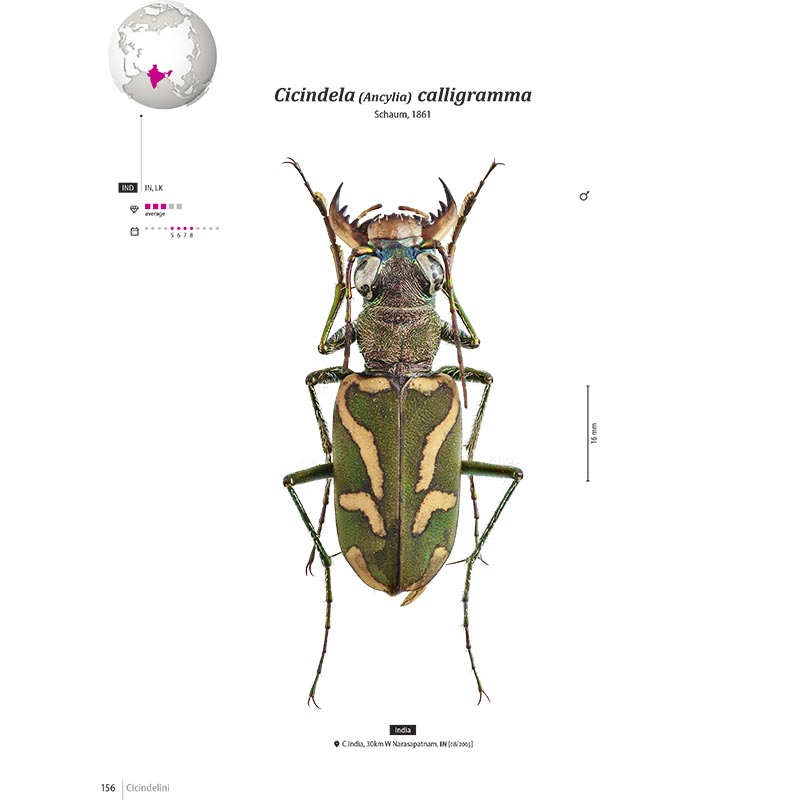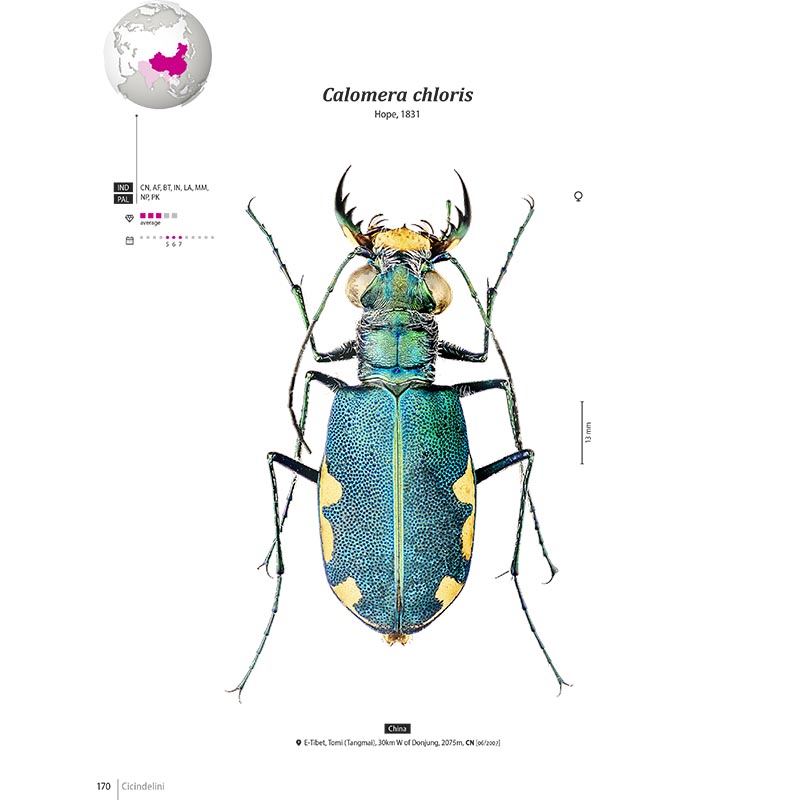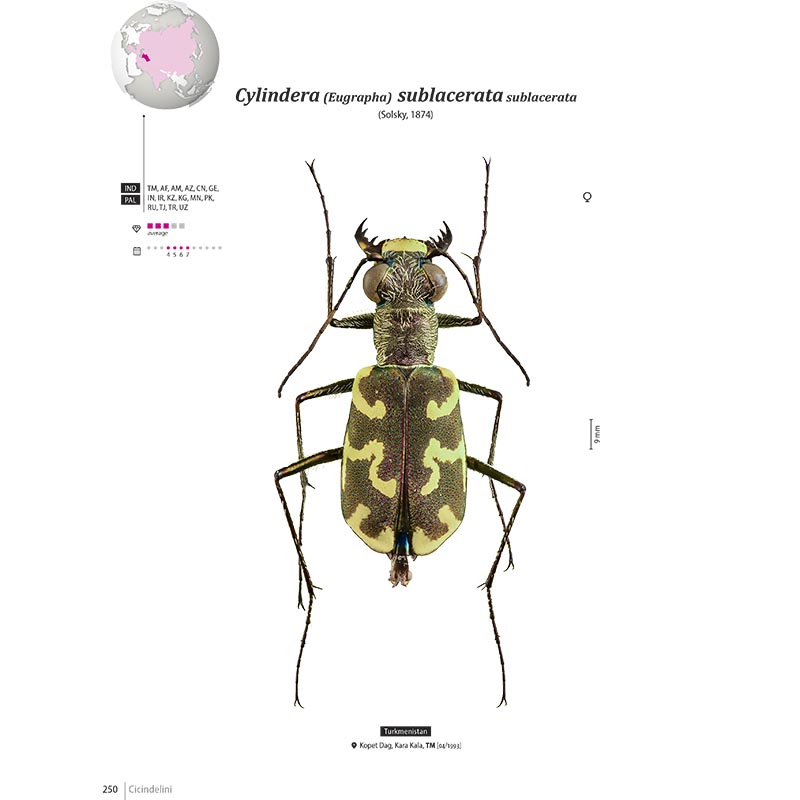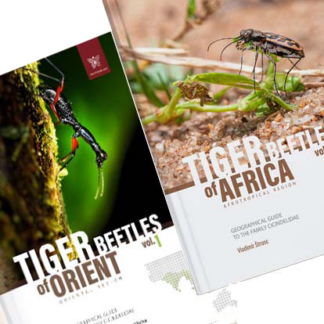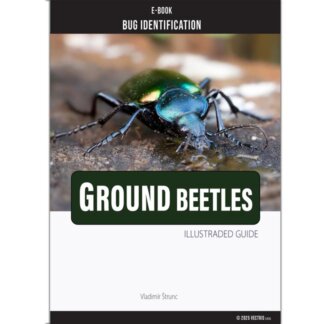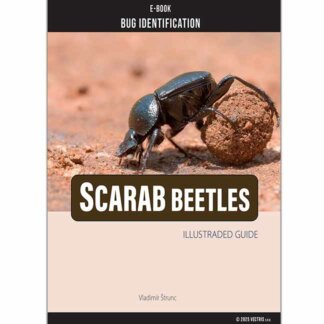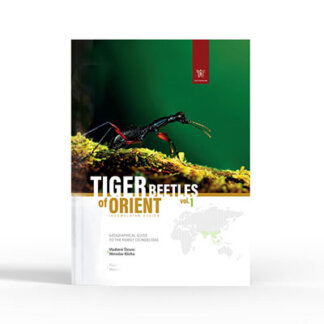Description
Uncovering the Tiger Beetles of Orient, Cicindelidae

The guide will help you get acquainted with 39 genera and 270 species/subspecies of the family Cicindelidae of the Oriental region. Main advantages: complete species lists unique Cicindelidae catalog excellent image resolution for ID hardcover and heavyweight paper 170g/m2 secure shipping discounts
URL: https://insect-books.com/shop/tiger-beetles-of-orient/
Author: Vladimír Štrunc
5
Pros
- complete species lists
- unique Cicindelidae catalog
- excellent image resolution for ID
- hardcover and heavyweight paper 170g/m2
- secure shipping
- discounts
Cons
- images predominate over text
- higher but acceptable price
Unique pictorial atlases for identifying Tiger Beetles of Orient, Cicindelidae aims to introduce these amazing predators of the insect world to all nature lovers. This book is the first in a series of books on tiger beetles organized by zoo area. The book introduces the Oriental region. The title was co-authored with Cicindelidae expert Miroslav Klícha.
Tiger Beetles of Orient I., Cicindelidae
Cicindelidae
The guide will help you get acquainted with 39 genera and 270 species/subspecies of the family Cicindelidae of the Oriental region.
List genera:
Abroscelis, Apteroessa, Callytron, Calochroa, Calomera, Cicindela, Collyris, Cosmodela, Cylindera, Derocrania, Derocrania, Dilatotarsa, Glomera, Guineica, Heptodonta, Hipparidium, Hypaetha, Jansenia, Leptognatha, Lophyra, Myriochila, Naviauxella, Neocollyris, Notospira, Oxygoniola, Polyrhanis, Probstia, Pronyssa, Prothyma, Protocollyris, Rhytidophaena, Salpingophora, etinteridenta, Sophiodela, Therates, Thopeutica, Tricondyla, Wallacedela
The book offers a comprehensive visual guide, featuring one or more representative species from each genus and subgenus. These are beautifully illustrated with large photographs, providing detailed information on sex, size, place of origin, and a map of the countries where each species is distributed. This wealth of information makes the book an invaluable resource for anyone interested in these fascinating creatures.
Each species is presented in ultra-high-resolution top view close-ups, so vivid that you’ll feel as though you’re right there with them. The use of UV inks on glossy chalk paper enhances the images, making them truly stand out. Some species have never been illustrated before, making this publication a groundbreaking contribution to the field. Whether you’re a professional or amateur entomologist, this guide is both an enthralling source of identification and a valuable tool for research.
Tiger beetles, in particular, are among the predatory insects that captivate thousands worldwide. Their allure is irresistible to photographers and nature observers alike. These remarkable insects are known for their aggressive predatory habits and impressive running speed, making them a compelling subject for study and observation. By exploring the world of tiger beetles, you’ll uncover the hidden wonders of these extraordinary insect predators. Embark on this remarkable journey today and discover the fascinating diversity of these creatures.
We recommend: jeweled beetles, ground beetles, tiger beetles, longhorn beetles, goliath beetle, stag beetle, carpet beetles
Tiger Beetles of Orient I., Cicindelidae
The Cicindelidae, commonly referred to as tiger beetles, is a family of beetles that includes more than 2,600 species. These insects are distinguished by their predatory habits, striking colors, and impressive speed. They are mainly located in subtropical and tropical areas, frequently inhabiting sunny trails or sandy environments.
Family Cicindelidae
These magnificent Tiger Beetles (Cicindelidae) are known for their remarkable speed, with some species reaching speeds of up to 9 km/h, making them one of the fastest insects relative to their size. This fascinating speed is made possible by their long legs and streamlined body, which allows them to navigate their environment quickly while hunting. They are primarily carnivores that feed on other insects, and their hunting strategy is to actively pursue prey rather than ambush it. Their sharp eyesight, aided by a nearly 360-degree field of view, enhances their ability to detect movement and find potential food sources.
Tiger Beetles of Orient I., Cicindelidae
Tiger beetles have a wide range of colours and patterns, often iridescent, which are used for camouflage and warning signals. Their breeding behaviour is interesting, with females laying eggs in sandy soil where the larvae can burrow and develop. Both adults and larvae are predatory, contributing to their role as effective pest controllers. However, many species face threats due to habitat loss and environmental change, highlighting the need for conservation efforts to maintain ecological balance. Overall, tiger beetles are a fascinating example of adaptation and specialization, offering valuable insights into ecosystem health and biodiversity. Tiger Beetles of Orient I., Cicindelidae
Tiger beetles are renowned for their incredible speed, with the Australian tiger beetle being the fastest running insect. If scaled to human size, some species would reach speeds equivalent to over 700 mph, making them faster than a cheetah. Their speed allows them to efficiently catch prey, such as small insects and spiders, using their powerful jaws. However, they also have predators, including birds and ants, which feed on their larvae.
These beetles primarily inhabit sandy areas and serve as bioindicators of ecosystem health. Their larvae live in burrows, where they ambush passing arthropods. In summer, adult tiger beetles emerge, displaying vibrant colors and impressive agility. There are over 2,600 species worldwide, each with unique characteristics. Notable species include the Australian tiger beetle (Cicindela hudsoni) and the Six-spotted Tiger Beetle, which is harmless to humans.
Tiger beetles are generally found in open, sandy habitats and are distributed across various regions, including the UK. The presence of water plays a crucial role in their habitat selection. Despite their predatory nature, they are not poisonous and pose no threat to humans. Their role in maintaining ecological balance highlights their importance in natural ecosystems.
There are misconceptions about tiger beetles, including references to “tiger beetle software,” which has no recognized scientific basis. Instead, tiger beetles are beneficial predators that help control insect populations. Their remarkable speed and adaptability make them fascinating subjects for scientific study and conservation efforts.
Uncovering the Tiger Beetles of Orient, Cicindelidae

The guide will help you get acquainted with 39 genera and 270 species/subspecies of the family Cicindelidae of the Oriental region. Main advantages: complete species lists unique Cicindelidae catalog excellent image resolution for ID hardcover and heavyweight paper 170g/m2 secure shipping discounts
URL: https://insect-books.com/shop/tiger-beetles-of-orient/
Author: Vladimír Štrunc
5
Pros
- complete species lists
- unique Cicindelidae catalog
- excellent image resolution for ID
- hardcover and heavyweight paper 170g/m2
- secure shipping
- discounts
Cons
- images predominate over text
- higher but acceptable price










